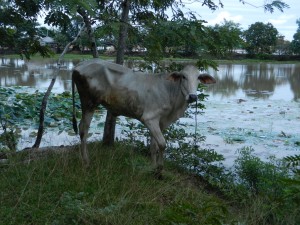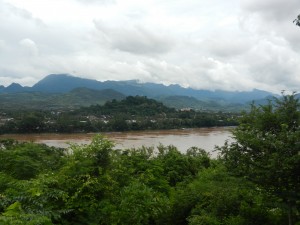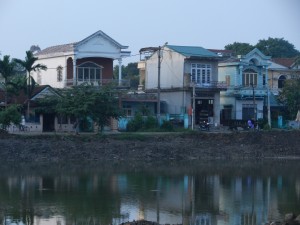Snakes fascinate people in cultures all over the world. But Southeast Asia’s rich natural landscape allowed an unusual number of ways that this potent symbol could become meaningful.
The abundant life forms in Southeast Asia often seem to flow together, and this landscape matches ideas of snakes as embodiments of nature’s prime energy. Let’s get primitive and explore this fecund convergence of nature and culture.
Southeast Asia’s rivers twist like snakes. And they surge during rainy seasons.
For example, the Mekong and tributaries seem to envelop Luang Prabang, Laos (seen above) in life’s energies. The sinuous mountains, profuse greenery and billowing clouds that bring the rains all converge into assumptions that nature’s basic patterns are full of twisting and surging energies.
Jungles and monsoons also reinforce these assumptions.
Many culures in Southeast Asia thus associated their origins with a serpent or a dragon.
Earliest Vietnamese myths say that their first kings (the Hung) were descended from Lac Long Quan (Lac Dragon Lord). He came to the Red River basin from his home in the sea, conquered the land’s demons and taught its people how to farm rice and wear clothes. Communities that looked like Hue (shown above) emerged. Lac Long Quan returned to the sea, but he first told his people to call on him if they’re ever in distress.
So it’s no surprise that serpent lore became a meeting point with Indian culture. The first large state in Cambodia, the Funan, emerged by 200 CE. Indians were sailing to Southeast Asia by then in search of gold. Silicon Valley didn’t yet exist, so Southeast Asia was the overseas place to go to get rich.
According to contemporary Chinese writers, the Funan believed that their first king was an Indian named Kaundinya, who came over on a trading ship. He married Soma, the beautiful daughter of the local naga (serpent) king. So here’s a dream team. The old associations between serpents and nature’s power were linked with immigrants bringing new religions (Hinduism and Buddhism) and technologies (writing). This happened when political states were growing. Nature’s energies were fused with both religious thought and political organization.
Some of the world’s most fascinating art forms followed. Serpents are infinitely creative. We’ll follow them in more posts.





Comments on this entry are closed.